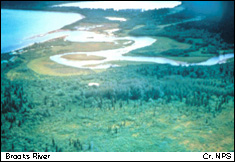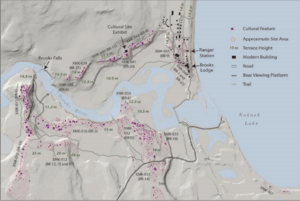Brooks River Archeological District facts for kids
|
Brooks River Archaeological District
|
|

Brooks River Archeological District
|
|
| Lua error in Module:Location_map at line 420: attempt to index field 'wikibase' (a nil value). | |
| Location | Address restricted , along Brooks River, Katmai National Park and Preserve |
|---|---|
| Nearest city | King Salmon |
| NRHP reference No. | 78000342 |
Quick facts for kids Significant dates |
|
| Added to NRHP | February 14, 1978 |
| Designated NHLD | April 19, 1993 |
The Brooks River Archaeological District is a very important historical area located in Katmai National Park and Preserve in Alaska. It's a place where many ancient human settlements have been discovered along the Brooks River. Scientists have found evidence that people lived here from about 2500 BCE (that's over 4,500 years ago!) all the way up to more recent times. Because of its rich history, this district was recognized as a special National Historic Landmark in 1993. Today, a part of this historic area is home to Brooks Camp, a popular spot for park visitors.
Contents
Discovering Ancient Life at Brooks River
The Brooks River is a short river that connects Brooks Lake to Naknek Lake in Katmai National Park and Preserve. This river is famous for its huge salmon runs, which attract many bears. Because of the abundant salmon, people have also used this area for hunting, fishing, and gathering food for thousands of years.
Why Brooks River Was a Great Place to Live
The area around Brooks River has always been a good place for people to live. The river provides lots of salmon, which was a main food source for ancient communities. Today, Brooks Camp is located on the north bank of the river, near Brooks Falls. Since the 1960s, archaeologists (scientists who study ancient human history) have been working here. They often find evidence of human homes and tools while managing the park's visitor facilities.
Volcanoes and History: A Layered Story
The land at Brooks River is like a giant history book, with each page made of volcanic ash! Over thousands of years, volcanoes in the region have erupted many times. Each eruption left behind a layer of ash. These ash layers help archaeologists understand different time periods. They can tell how old a settlement is by which ash layer it's found under or between.
The most recent big eruption was from Novarupta in 1912. This eruption was so powerful it helped create Katmai National Park. It also destroyed many Native villages closer to the volcano. After this, some people moved to the Brooks River area.
What Archaeologists Have Found
Scientists have found evidence of human life in at least ten different layers of volcanic ash, dating back to 6500 BCE. The oldest human sites at Brooks River are from around 3000 BCE.
Some of the amazing things found include:
- Pit houses: These were homes dug partly into the ground, similar to traditional barabaras used by Native Alaskans.
- Stone tools: People made tools for hunting, fishing, and daily life from stone.
- Projectile points: These are the tips of spears or arrows used for hunting.
- Debitage: This is the leftover stone flakes from making tools. It shows where people worked on their tools.
One interesting discovery happened when the National Park Service was preparing a house site for visitors. Heavy rains caused a trench to be dug to drain water. This new trench accidentally revealed even more ancient sites, showing just how much history is hidden beneath the surface at Brooks River!


